INSTITUT SUPERIEUR D'ANTHROPOLOGIE
INSTITUTE OF ANTHROPOLOGY
ONLINE COURSES / COURS A DISTANCE
DEBUT COURS : SEPTEMBRE 2023
REGISTER NOW
CHYPRE –  Palaepaphos - The University of Cyprus’s Archeology Research Unit directed its focus this year toward excavating a buried fortress beneath the Laona tumulus in Palaepaphos (Kouklia village), which dates back to the Cypro-Classical period. The primary objective is to unearth and showcase the fortress, situated at an approximate height of 3 metres. Subsequently, the Polytechnic University of Milan will undertake the digital mapping of the revealed structure.These excavations are part of an analytical programme concerning the urban landscape of Ancient Paphos. Aside from the renowned Aphrodite sanctuary, Palaepaphos boasts an expansive administrative landscape (citadel) from the Cypro-Classical period. This complex includes defensive, palace, and laboratory structures erected by the Paphos dynasties during the 5th and 4th centuries BC. The UCy press release said: “After the completion of the geomorphological study and the publication of the findings concerning the construction of the Laona tumulus, which was the focus of research for a decade (2012-2022), the mission of May-June 2023 was exclusively dedicated to the excavation of the monumental fortress settlement of the Cypro-Classical period (5th-4th centuries BC) which was found buried under the tumulus.” The press release indicated that based on the digital division of the tumulus into excavation blocks (4x4m), approximately 500 square meters of exposed tumulus layers were analysed. Thus far, no indications of a burial chamber have emerged. However, significant progress was achieved this year, unveiling the eastern and northwestern sides of the fortress complex, spanning a length of over 135 meters. Additionally, three access stairs leading to the fortress’s pinnacle were unearthed—two scales facing each other on the eastern side and a third farther north, situated beneath the preserved top of the tumulus at an elevation of 114 meters above sea level. The Department of Antiquities’ press release noted that comprehensive investigations of the fortress’s northern slope revealed that the wall was entirely constructed using stone. The release highlighted, “Artemis Karnava was able to identify the syllabic letter ‘E’ on a large worked stone at the exterior base of the fortress, which may represent the first letter of the mason’s name.” The University of Cyprus’s press release highlighted that the anticipated maximum preservation height of the monument concealed beneath the tumulus ranges between 4 to 7 meters. While the southern portion of the wall, not obscured by mound layers, retains a height of only 1 to 1.5 meters, it is crafted using impressive second-use dressed stones. The press release also noted that the southward expansion of the monumental defence complex of Laona faced interruptions due to extensive erosion caused by agricultural levelling. Despite this, the distance between the palace building on the Hadjiabdoulla plateau has been reduced to a mere 30 meters. Anticipating the upcoming excavation period in 2024, it is expected that the Laona wall will be interconnected with the wall safeguarding the palace’s eastern side. On the Hadjiabdoulla plateau, the University of Cyprus mission identified and excavated an expansive laboratory complex adjacent to the palace’s western facade. “Today, it is considered certain that in these two neighbouring places, Laona and Hadjiabdoulla, the royal dynasties of the 5th and 4th centuries BC had invested in the construction of modern memorial facilities of various uses,” the press release said.
Palaepaphos - The University of Cyprus’s Archeology Research Unit directed its focus this year toward excavating a buried fortress beneath the Laona tumulus in Palaepaphos (Kouklia village), which dates back to the Cypro-Classical period. The primary objective is to unearth and showcase the fortress, situated at an approximate height of 3 metres. Subsequently, the Polytechnic University of Milan will undertake the digital mapping of the revealed structure.These excavations are part of an analytical programme concerning the urban landscape of Ancient Paphos. Aside from the renowned Aphrodite sanctuary, Palaepaphos boasts an expansive administrative landscape (citadel) from the Cypro-Classical period. This complex includes defensive, palace, and laboratory structures erected by the Paphos dynasties during the 5th and 4th centuries BC. The UCy press release said: “After the completion of the geomorphological study and the publication of the findings concerning the construction of the Laona tumulus, which was the focus of research for a decade (2012-2022), the mission of May-June 2023 was exclusively dedicated to the excavation of the monumental fortress settlement of the Cypro-Classical period (5th-4th centuries BC) which was found buried under the tumulus.” The press release indicated that based on the digital division of the tumulus into excavation blocks (4x4m), approximately 500 square meters of exposed tumulus layers were analysed. Thus far, no indications of a burial chamber have emerged. However, significant progress was achieved this year, unveiling the eastern and northwestern sides of the fortress complex, spanning a length of over 135 meters. Additionally, three access stairs leading to the fortress’s pinnacle were unearthed—two scales facing each other on the eastern side and a third farther north, situated beneath the preserved top of the tumulus at an elevation of 114 meters above sea level. The Department of Antiquities’ press release noted that comprehensive investigations of the fortress’s northern slope revealed that the wall was entirely constructed using stone. The release highlighted, “Artemis Karnava was able to identify the syllabic letter ‘E’ on a large worked stone at the exterior base of the fortress, which may represent the first letter of the mason’s name.” The University of Cyprus’s press release highlighted that the anticipated maximum preservation height of the monument concealed beneath the tumulus ranges between 4 to 7 meters. While the southern portion of the wall, not obscured by mound layers, retains a height of only 1 to 1.5 meters, it is crafted using impressive second-use dressed stones. The press release also noted that the southward expansion of the monumental defence complex of Laona faced interruptions due to extensive erosion caused by agricultural levelling. Despite this, the distance between the palace building on the Hadjiabdoulla plateau has been reduced to a mere 30 meters. Anticipating the upcoming excavation period in 2024, it is expected that the Laona wall will be interconnected with the wall safeguarding the palace’s eastern side. On the Hadjiabdoulla plateau, the University of Cyprus mission identified and excavated an expansive laboratory complex adjacent to the palace’s western facade. “Today, it is considered certain that in these two neighbouring places, Laona and Hadjiabdoulla, the royal dynasties of the 5th and 4th centuries BC had invested in the construction of modern memorial facilities of various uses,” the press release said.
https://in-cyprus.philenews.com/news/local/ucy-unearths-buried-fortress-dating-back-to-cypro-classical-era/
TURQUIE – 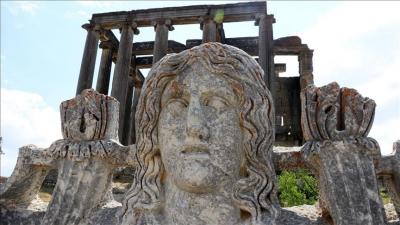 Aizanoi - The recent excavation of the agora in the ancient city of Aizanoi in western Türkiye is expected to shed new light on the city's trade life, said a Turkish official. Speaking to Anadolu, Kutahya Governor Ali Celik said that the excavations carried out in the region have gained great momentum recently. Noting that most of the shops in the ancient bazaar of the city, called Agora, will be uncovered this year, Celik said: “We started to uncover the agora and the work intensified here.” “The excavations of five shops in the agora are expected to be completed this year,” Celik added. “By uncovering the agora, we will integrate the Temple of Zeus, the trade areas, and the monumental structures of the city from that period,” he added. Celik emphasized that the complete exposure of the agora will shed light on the commercial life of Aizanoi. Located 57 kilometers (35 miles) from the Kutahya city center, the ancient site saw its golden age in the second and third centuries AD and became “the center of the episcopacy in the Byzantine era," according to the website of the Turkish Culture and Tourism Ministry. Recent excavations around the Temple of Zeus indicate the existence of several levels of settlement in the city dating from as far back as 3000 BC. In 133 BC, it was captured by the Roman Empire.
Aizanoi - The recent excavation of the agora in the ancient city of Aizanoi in western Türkiye is expected to shed new light on the city's trade life, said a Turkish official. Speaking to Anadolu, Kutahya Governor Ali Celik said that the excavations carried out in the region have gained great momentum recently. Noting that most of the shops in the ancient bazaar of the city, called Agora, will be uncovered this year, Celik said: “We started to uncover the agora and the work intensified here.” “The excavations of five shops in the agora are expected to be completed this year,” Celik added. “By uncovering the agora, we will integrate the Temple of Zeus, the trade areas, and the monumental structures of the city from that period,” he added. Celik emphasized that the complete exposure of the agora will shed light on the commercial life of Aizanoi. Located 57 kilometers (35 miles) from the Kutahya city center, the ancient site saw its golden age in the second and third centuries AD and became “the center of the episcopacy in the Byzantine era," according to the website of the Turkish Culture and Tourism Ministry. Recent excavations around the Temple of Zeus indicate the existence of several levels of settlement in the city dating from as far back as 3000 BC. In 133 BC, it was captured by the Roman Empire.
https://www.aa.com.tr/en/culture/agora-excavation-in-aizanoi-to-shed-light-on-trade-life-of-ancient-city/2959193
TURQUIE –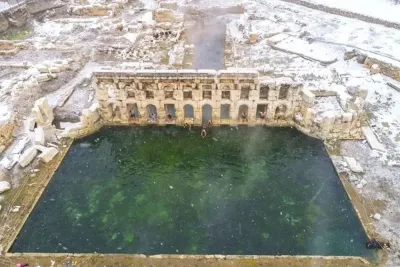
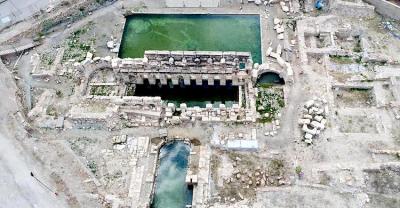 Kral Kızı Hamamı - The 2,000-year-old Roman bathhouse Basilica Therma or King’s Daughter in Türkiye’s central Yozgat province is nearing the final stages of its extensive landscaping restoration, Yozgat Governor Ziya Polat noted recently. The Basilica Therma Roman Bath, known as the ‘King’s Daughter’ (Turkish: Kral Kızı Hamamı or Sarıkaya Roma Hamamı) is an ancient Roman spa town located in the Yozgat province of Turkey. This historic gem, inscribed on UNESCO’s Temporary World Heritage List in 2018, has been undergoing a transformative restoration effort to highlight its remarkable architecture, rich history, and the therapeutic thermal water flowing at a soothing 50 degrees Celsius (122 degrees Fahrenheit). The landscaping project on the ancient structure, known for its thermal water pools that allow swimming even in the dead of winter, began in 2022 under the supervision of the Museum Directorate. The Roman Bath, which was unearthed after the excavations carried out in 2014 by the Yozgat Governorship Provincial Culture and Tourism Directorate and Sarıkaya Municipality, draws attention to its interesting architecture, history, and water that has been produced for two thousand years. This Roman Bath that was built in the 2nd century A.D. has been used continuously and this gorgeous fountain still continues to be a source of healing with thermal waters. Due to this nearby thermal spring, the town on the route from Tavium to Caesarea during the Roman era was known as Aquae Sarvenae. A church was later added to the bath’s northern portion as Christianity spread throughout the area. As a result, the town’s name was changed to Basilica Therma. Basilica Therma served as a bishopric center up until 451 AD. The center of the town was a Roman bath and the town was surrounded by a wall about three kilometers long. The facade and pools of the Roman Baths were made of marble, while the inner walls were made of limestone. Today, the main parts of the structure can be seen: a western facade, a large thermal pool in front of it, an inner pool behind the facade, and a third pool to the east. On the northern and southern sides of the 30-meter-long facade, two small semi-circle pools are planned. Behind the façade is an inner pool surrounded on both sides by stairs and arches that connect directly to the large pool in front.
Kral Kızı Hamamı - The 2,000-year-old Roman bathhouse Basilica Therma or King’s Daughter in Türkiye’s central Yozgat province is nearing the final stages of its extensive landscaping restoration, Yozgat Governor Ziya Polat noted recently. The Basilica Therma Roman Bath, known as the ‘King’s Daughter’ (Turkish: Kral Kızı Hamamı or Sarıkaya Roma Hamamı) is an ancient Roman spa town located in the Yozgat province of Turkey. This historic gem, inscribed on UNESCO’s Temporary World Heritage List in 2018, has been undergoing a transformative restoration effort to highlight its remarkable architecture, rich history, and the therapeutic thermal water flowing at a soothing 50 degrees Celsius (122 degrees Fahrenheit). The landscaping project on the ancient structure, known for its thermal water pools that allow swimming even in the dead of winter, began in 2022 under the supervision of the Museum Directorate. The Roman Bath, which was unearthed after the excavations carried out in 2014 by the Yozgat Governorship Provincial Culture and Tourism Directorate and Sarıkaya Municipality, draws attention to its interesting architecture, history, and water that has been produced for two thousand years. This Roman Bath that was built in the 2nd century A.D. has been used continuously and this gorgeous fountain still continues to be a source of healing with thermal waters. Due to this nearby thermal spring, the town on the route from Tavium to Caesarea during the Roman era was known as Aquae Sarvenae. A church was later added to the bath’s northern portion as Christianity spread throughout the area. As a result, the town’s name was changed to Basilica Therma. Basilica Therma served as a bishopric center up until 451 AD. The center of the town was a Roman bath and the town was surrounded by a wall about three kilometers long. The facade and pools of the Roman Baths were made of marble, while the inner walls were made of limestone. Today, the main parts of the structure can be seen: a western facade, a large thermal pool in front of it, an inner pool behind the facade, and a third pool to the east. On the northern and southern sides of the 30-meter-long facade, two small semi-circle pools are planned. Behind the façade is an inner pool surrounded on both sides by stairs and arches that connect directly to the large pool in front.
https://arkeonews.net/restoration-of-turkiyes-2000-year-old-kings-daughter-roman-bath-nears-completion/
ALLEMAGNE – 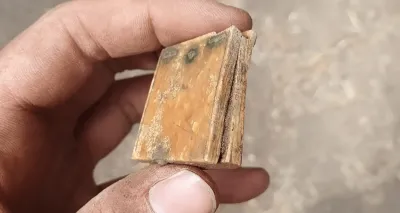 Marburg - A rare Medieval sundial, which is approximately the size of a matchbox was discovered in the old town of Marburg, Germany. According to a statement from Marburg University, students were digging a church site in the town when they discovered the sundial. The sundial is constructed of bronze and wood. The old clock, which is thought to be from the late medieval era, is thought to have belonged to the Brethren of the Common Life, a monastic order that was founded in the Netherlands in the late 14th century. It was a community established by Gerard Groote, a Dutch Catholic deacon. Eventually, the Brethren spread to the Netherlands, Germany, and Switzerland. They settled in the old monastery structure from 1527, situated in the upper part of Marburg. “The sensational find provides a clear insight into the meeting of a high level of knowledge in astronomy and mathematics with specialized craftsmanship on the threshold from the Middle Ages to modern times,” explains the head of the educational excavation,” Professor Dr. Felix Teichner said in a press statement. According to Professor Teichner, of the Department of History and Cultural Studies at the Philipps University of Marburg, it’s the first time an object like this has been found in Hesse, the German state, and not many such sundials are left.
Marburg - A rare Medieval sundial, which is approximately the size of a matchbox was discovered in the old town of Marburg, Germany. According to a statement from Marburg University, students were digging a church site in the town when they discovered the sundial. The sundial is constructed of bronze and wood. The old clock, which is thought to be from the late medieval era, is thought to have belonged to the Brethren of the Common Life, a monastic order that was founded in the Netherlands in the late 14th century. It was a community established by Gerard Groote, a Dutch Catholic deacon. Eventually, the Brethren spread to the Netherlands, Germany, and Switzerland. They settled in the old monastery structure from 1527, situated in the upper part of Marburg. “The sensational find provides a clear insight into the meeting of a high level of knowledge in astronomy and mathematics with specialized craftsmanship on the threshold from the Middle Ages to modern times,” explains the head of the educational excavation,” Professor Dr. Felix Teichner said in a press statement. According to Professor Teichner, of the Department of History and Cultural Studies at the Philipps University of Marburg, it’s the first time an object like this has been found in Hesse, the German state, and not many such sundials are left.
https://arkeonews.net/a-very-rare-medieval-pocket-sundial-discovered-in-germany/
ALLEMAGNE –
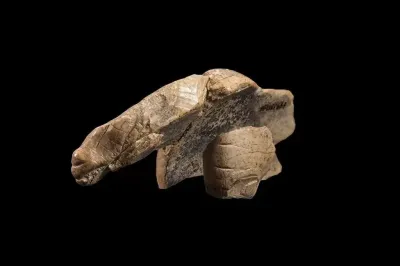
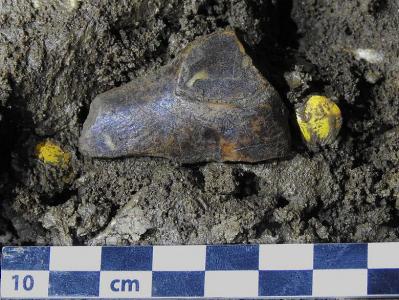 Hohle Fels - For more than 20 years, the first ivory work of art recovered from the World Heritage cave Hohle Fels was believed to be a horse – until archaeologists made a new discovery. During excavations in the World Heritage cave Hohle Fels in the Swabian Jura near Schelklingen, archaeologists recently recovered a fragment of a carefully carved ivory figurine that gives one of the most famous Ice Age works of art a new look: the figurine fragment turned out to be a piece of a body that was perfectly adapted to an animal figurehead found more than 20 years ago. The head, recovered in 1999, became famous as the first ivory figurine found in Hohle Fels and had previously been interpreted as part of a horse figure. Professor Nicholas Conard’s team from the Department of Prehistory and Quaternary Ecology at the University of Tübingen is now questioning this assessment: “We still cannot identify the animal species depicted with certainty, but it could be a cave lion or a cave bear,” said Professor Conard at one Press conference on the “Find of the Year” on Thursday. A scholarly publication on the figure, parts of which were recovered in layers of the Aurignacian Palaeolithic culture and carved 35,000 years ago, appears in the current issue of the journal Archaeological Excavations in Baden-Württemberg, published by the Baden-Württemberg State Office for the Preservation of Monuments.Professor Conard himself considers the work of art from the Upper Paleolithic to be a bear figure: “The figurine now has a massive body, shows the typical pronounced bear hump at shoulder height and presents itself in a posture that could imitate the trotting gait of a bear.” But there is Even colleagues who ascribed the figure the anatomical and physiognomic properties of a cave lion, Professor Conard admits: »It is by no means always easy to determine Ice Age depictions with certainty, especially when they are preserved in such fragmentary form. It therefore makes sense to look particularly carefully for the missing parts of this animal in the years to come. In fact, the animal figure is now composed of five find fragments that were recovered in different years of excavation: Shortly thereafter, a small piece of the cheek was identified among the ivory finds and adapted to the head found in 1999, which was broken off in the neck area. This is how the find was kept for a good twenty years Prehistoric Museum in Blaubeuren (urmu) displayed. The current ivory find, which is 3.99 centimeters long, 2.49 centimeters high and 0.55 centimeters thick and features several fine, deliberately engraved line patterns on one side, was identified as the animal’s right shoulder and thorax shortly after excavation and attached. This led the researchers to look for other parts of the figurine among the numerous ivory finds from Hohle Fels. With success: Another small part of the right side of the body could be found on the basis of its engravings. This small piece of torso attached to the figure, like the other pieces, bears very fine lines of the same finish, which clearly demonstrate the coherence of the compositions. It is very likely that another fragment also belongs to the figure: It could be part of the left front leg, but which cannot be directly connected to the rest of the body.
Hohle Fels - For more than 20 years, the first ivory work of art recovered from the World Heritage cave Hohle Fels was believed to be a horse – until archaeologists made a new discovery. During excavations in the World Heritage cave Hohle Fels in the Swabian Jura near Schelklingen, archaeologists recently recovered a fragment of a carefully carved ivory figurine that gives one of the most famous Ice Age works of art a new look: the figurine fragment turned out to be a piece of a body that was perfectly adapted to an animal figurehead found more than 20 years ago. The head, recovered in 1999, became famous as the first ivory figurine found in Hohle Fels and had previously been interpreted as part of a horse figure. Professor Nicholas Conard’s team from the Department of Prehistory and Quaternary Ecology at the University of Tübingen is now questioning this assessment: “We still cannot identify the animal species depicted with certainty, but it could be a cave lion or a cave bear,” said Professor Conard at one Press conference on the “Find of the Year” on Thursday. A scholarly publication on the figure, parts of which were recovered in layers of the Aurignacian Palaeolithic culture and carved 35,000 years ago, appears in the current issue of the journal Archaeological Excavations in Baden-Württemberg, published by the Baden-Württemberg State Office for the Preservation of Monuments.Professor Conard himself considers the work of art from the Upper Paleolithic to be a bear figure: “The figurine now has a massive body, shows the typical pronounced bear hump at shoulder height and presents itself in a posture that could imitate the trotting gait of a bear.” But there is Even colleagues who ascribed the figure the anatomical and physiognomic properties of a cave lion, Professor Conard admits: »It is by no means always easy to determine Ice Age depictions with certainty, especially when they are preserved in such fragmentary form. It therefore makes sense to look particularly carefully for the missing parts of this animal in the years to come. In fact, the animal figure is now composed of five find fragments that were recovered in different years of excavation: Shortly thereafter, a small piece of the cheek was identified among the ivory finds and adapted to the head found in 1999, which was broken off in the neck area. This is how the find was kept for a good twenty years Prehistoric Museum in Blaubeuren (urmu) displayed. The current ivory find, which is 3.99 centimeters long, 2.49 centimeters high and 0.55 centimeters thick and features several fine, deliberately engraved line patterns on one side, was identified as the animal’s right shoulder and thorax shortly after excavation and attached. This led the researchers to look for other parts of the figurine among the numerous ivory finds from Hohle Fels. With success: Another small part of the right side of the body could be found on the basis of its engravings. This small piece of torso attached to the figure, like the other pieces, bears very fine lines of the same finish, which clearly demonstrate the coherence of the compositions. It is very likely that another fragment also belongs to the figure: It could be part of the left front leg, but which cannot be directly connected to the rest of the body.
https://arkeonews.net/the-first-ivory-work-of-art-recovered-from-the-world-heritage-cave-hohle-fels-was-believed-to-be-a-horse-until-archaeologists-made-a-new-discovery/
CHYPRE –  Peyia - Ancient human remains, stone anchors and Late Roman amphorae are amongst the “significant cultural treasures” atop and near Geronisos island uncovered during a three-month archaeological programme. The antiquities department announced on Wednesday that a team of local and international experts investigated an ancient necropolis, harbour and other key sites near Peyia, Paphos. The survey, excavation and study programme of the harbor, island and mainland coast of Cape Drepanum made several key discoveries, including a family tomb which was in continuous use from Late Hellenistic through Roman times, roughly from the 1st century BC to the 3rd, possibly early 4th century AD. Preliminary results show at least six individuals (including five adults and one adolescent) buried in the tomb chamber as well as four infants (including one fetus) buried in a concavity at the base of the dromos, just outside the chamber. The New York University team focused on the excavation of the important rock-cut tomb they first discovered in 2018 at the necropolis of Meletis, roughly half a kilometre inland from Ayios Georgios. Other finds at the tomb include a stepped dromos leading down to a main chamber with two loculi and two tetrasolia. The tomb’s abundant oil jars, jugs, laygnoi, table amphorae, and lamps are also being studied, as are Roman cooking pottery. A vast amount of glass and glass fragments were also recovered. Other finds include bollards for the mooring of ships, and excavation of a highly significant deposit of Hellenistic rooftiles – which was described as “[being] both the Laconian and Corinthian type and indicate the importance and monumentality of the structures built on Geronisos”. Another team undertook typological and quantification analysis of the vast deposits of late Roman amphorae, dumped along the shores of Maniki harbour. The great majority of vessels are of Late Roman 1 type and of local Paphian manufacture. Significant imports include two types of Late Roman amphorae from the Levant, ‘Gaza Jars’ and so called ‘Palestinian bag-shaped amphorae’, pointing to important trade connections with South Palestine during the mid-6th century AD. Another key part of the programme was the comprehensive coastal and underwater survey of Maniki harbour and the entire Cape Drepanum area. They have executed aerial mapping, 3-D modelling of the coast from the sea caves to the Aspros River, have lifted a series of stone anchors from the sea floor, and identified bollards for the mooring of ships.
Peyia - Ancient human remains, stone anchors and Late Roman amphorae are amongst the “significant cultural treasures” atop and near Geronisos island uncovered during a three-month archaeological programme. The antiquities department announced on Wednesday that a team of local and international experts investigated an ancient necropolis, harbour and other key sites near Peyia, Paphos. The survey, excavation and study programme of the harbor, island and mainland coast of Cape Drepanum made several key discoveries, including a family tomb which was in continuous use from Late Hellenistic through Roman times, roughly from the 1st century BC to the 3rd, possibly early 4th century AD. Preliminary results show at least six individuals (including five adults and one adolescent) buried in the tomb chamber as well as four infants (including one fetus) buried in a concavity at the base of the dromos, just outside the chamber. The New York University team focused on the excavation of the important rock-cut tomb they first discovered in 2018 at the necropolis of Meletis, roughly half a kilometre inland from Ayios Georgios. Other finds at the tomb include a stepped dromos leading down to a main chamber with two loculi and two tetrasolia. The tomb’s abundant oil jars, jugs, laygnoi, table amphorae, and lamps are also being studied, as are Roman cooking pottery. A vast amount of glass and glass fragments were also recovered. Other finds include bollards for the mooring of ships, and excavation of a highly significant deposit of Hellenistic rooftiles – which was described as “[being] both the Laconian and Corinthian type and indicate the importance and monumentality of the structures built on Geronisos”. Another team undertook typological and quantification analysis of the vast deposits of late Roman amphorae, dumped along the shores of Maniki harbour. The great majority of vessels are of Late Roman 1 type and of local Paphian manufacture. Significant imports include two types of Late Roman amphorae from the Levant, ‘Gaza Jars’ and so called ‘Palestinian bag-shaped amphorae’, pointing to important trade connections with South Palestine during the mid-6th century AD. Another key part of the programme was the comprehensive coastal and underwater survey of Maniki harbour and the entire Cape Drepanum area. They have executed aerial mapping, 3-D modelling of the coast from the sea caves to the Aspros River, have lifted a series of stone anchors from the sea floor, and identified bollards for the mooring of ships.
https://cyprus-mail.com/2023/08/02/excavations-reveal-significant-cultural-treasures-off-peyia/